Abstract
We have seen that there is no simple answer to the question 'what controls respiration?' The answer varies with (a) the size of the system examined (mitochondria, cell or organ), (b) the conditions (rate of ATP use, level of hormonal stimulation), and (c) the particular organ examined. Of the various theories of control of respiration outlined in the introduction the ideas of Chance & Williams (1955, 1956) give the basic mechanism of how respiration is regulated. Increased ATP usage can cause increased respiration and ATP synthesis by mass action in all the main tissues. Superimposed on this basic mechanism is calcium control of matrix dehydrogenases (at least in heart and liver), and possibly also of the respiratory chain (at least in liver) and ATP synthase (at least in heart). In many tissues calcium also stimulates ATP usage directly; thus calcium may stimulate energy metabolism at (at least) four possible sites, the importance of each regulation varying with tissue. Regulation of multiple sites may occur (from a teleological point of view) because: (a) energy metabolism is branched and thus proportionate regulation of branches is required in order to maintain constant fluxes to branches (e.g. to proton leak or different ATP uses); and/or (b) control over fluxes is shared by a number of reactions, so that large increases in flux requires stimulation at multiple sites because each site has relatively little control. Control may be distributed throughout energy metabolism, possibly due to the necessity of minimizing cell protein levels (see Brown, 1991). The idea that energy metabolism is regulated by energy charge (as proposed by Atkinson, 1968, 1977) is misleading in mammals. Neither mitochondrial ATP synthesis nor cellular ATP usage is a unique function of energy charge as AMP is not a significant regulator (see for example Erecinska et al., 1977). The near-equilibrium hypothesis of Klingenberg (1961) and Erecinska & Wilson (1982) is partially correct in that oxidative phosphorylation is often close to equilibrium (apart from cytochrome oxidase) and as a consequence respiration and ATP synthesis are mainly regulated by (a) the phosphorylation potential, and (b) the NADH/NAD+ ratio. However, oxidative phosphorylation is not always close to equilibrium, at least in isolated mitochondria, and relative proximity to equilibrium does not prevent the respiratory chain, the proton leak, the ATP synthase and ANC having significant control over the fluxes. Thus in some conditions respiration rate correlates better with [ADP] than with phosphorylation potential, and may be relatively insensitive to mitochondrial NADH/NAD+ ratio.(ABSTRACT TRUNCATED AT 400 WORDS)
Full text
PDF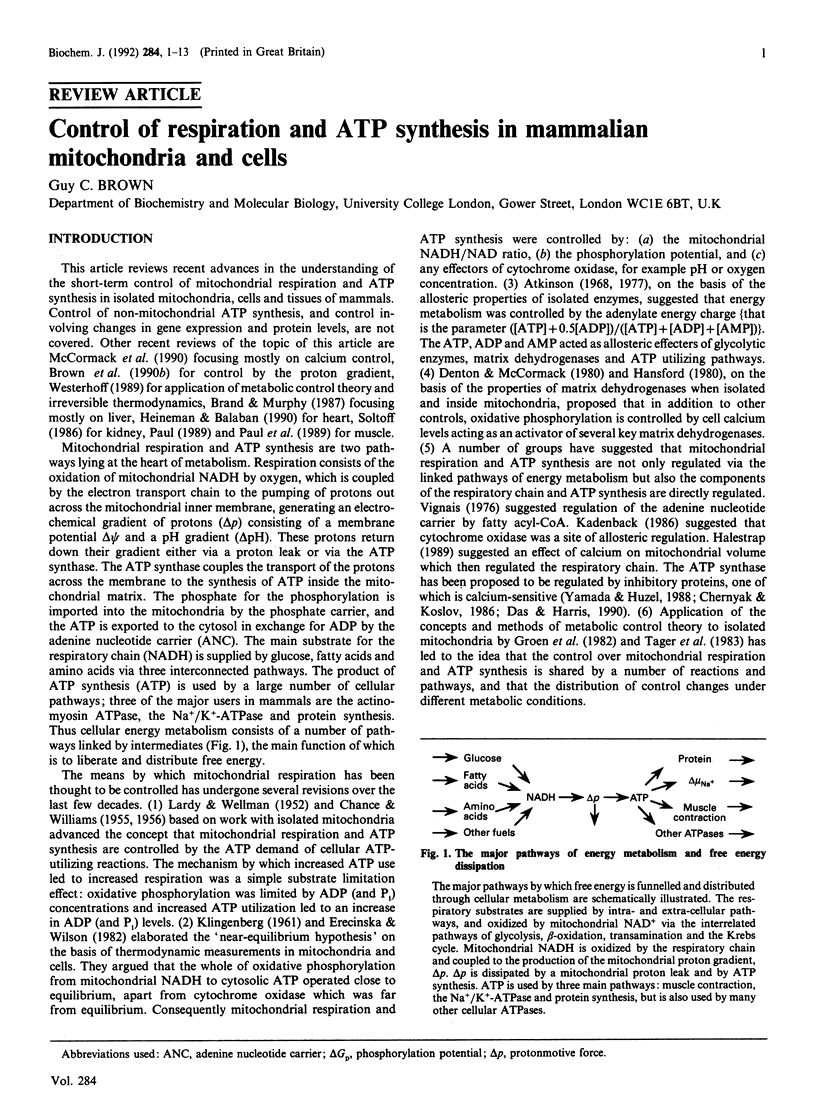
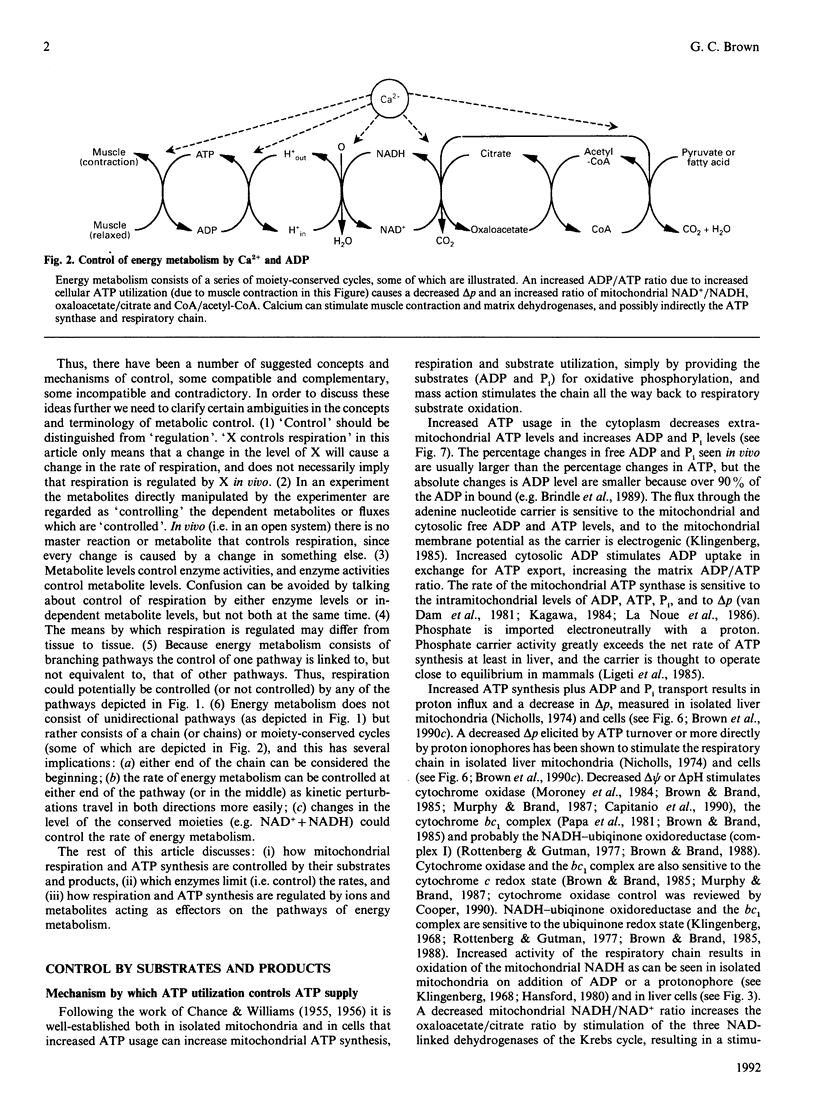
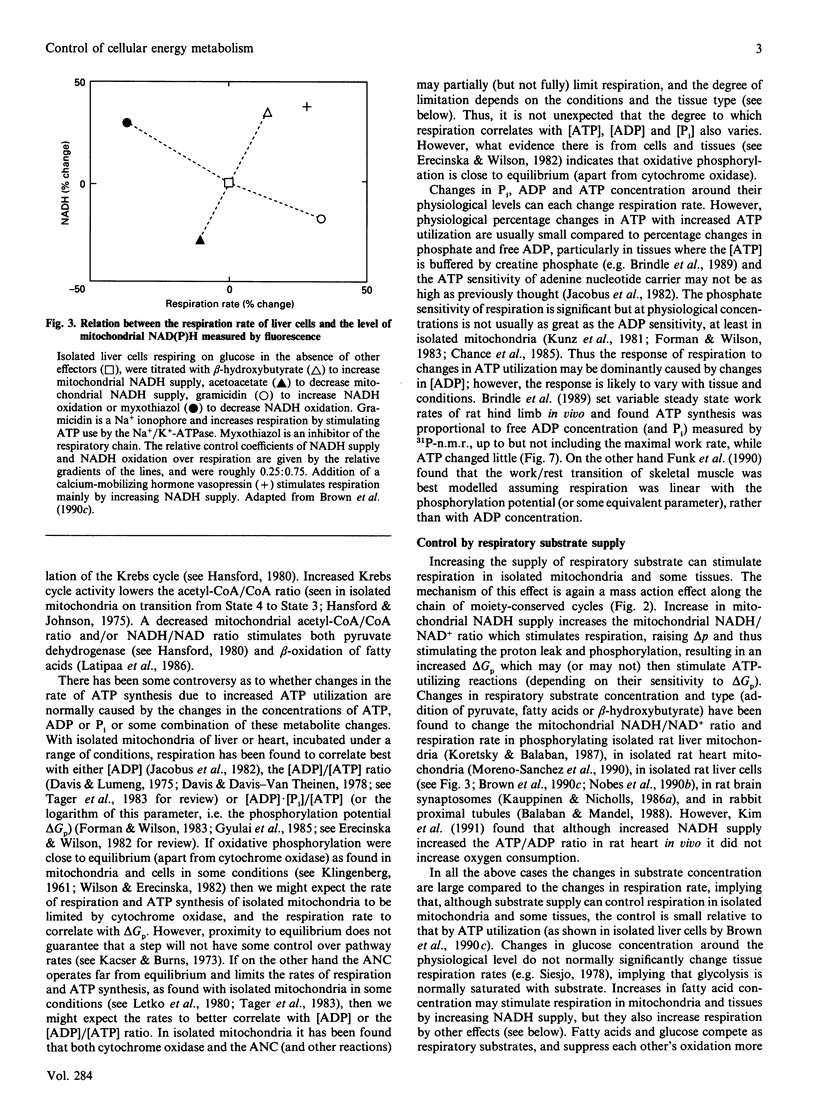
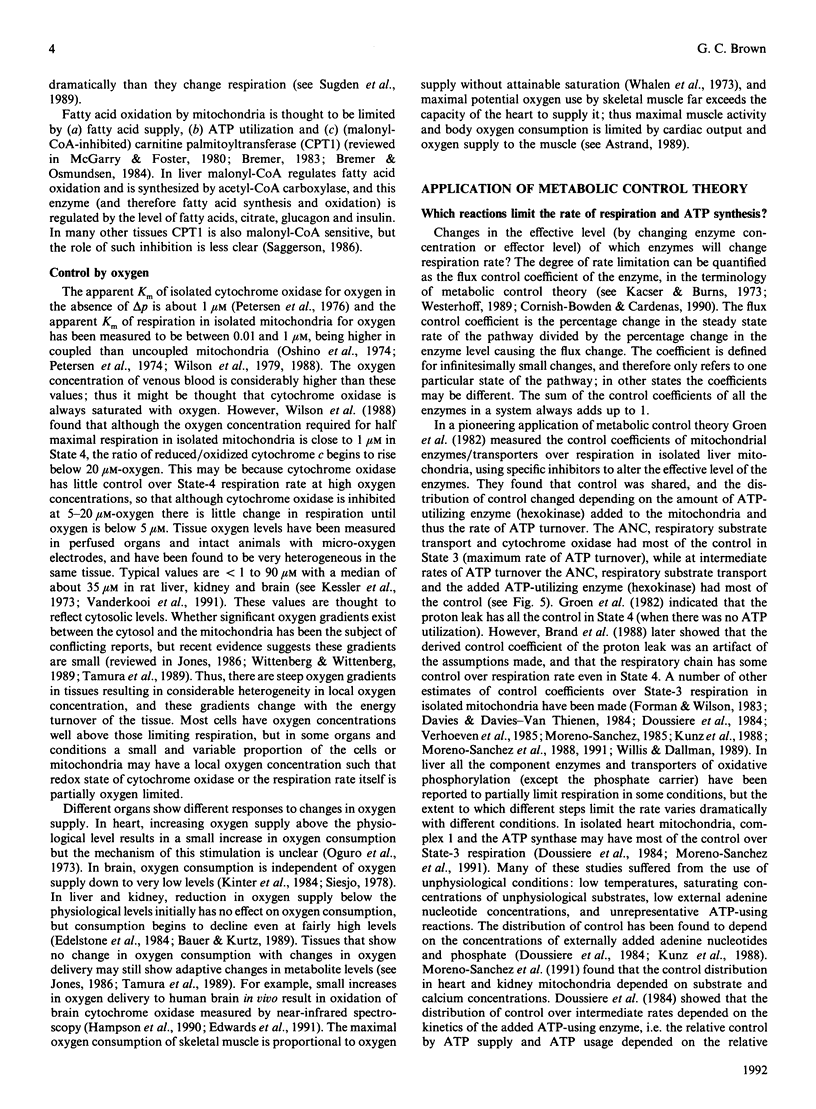
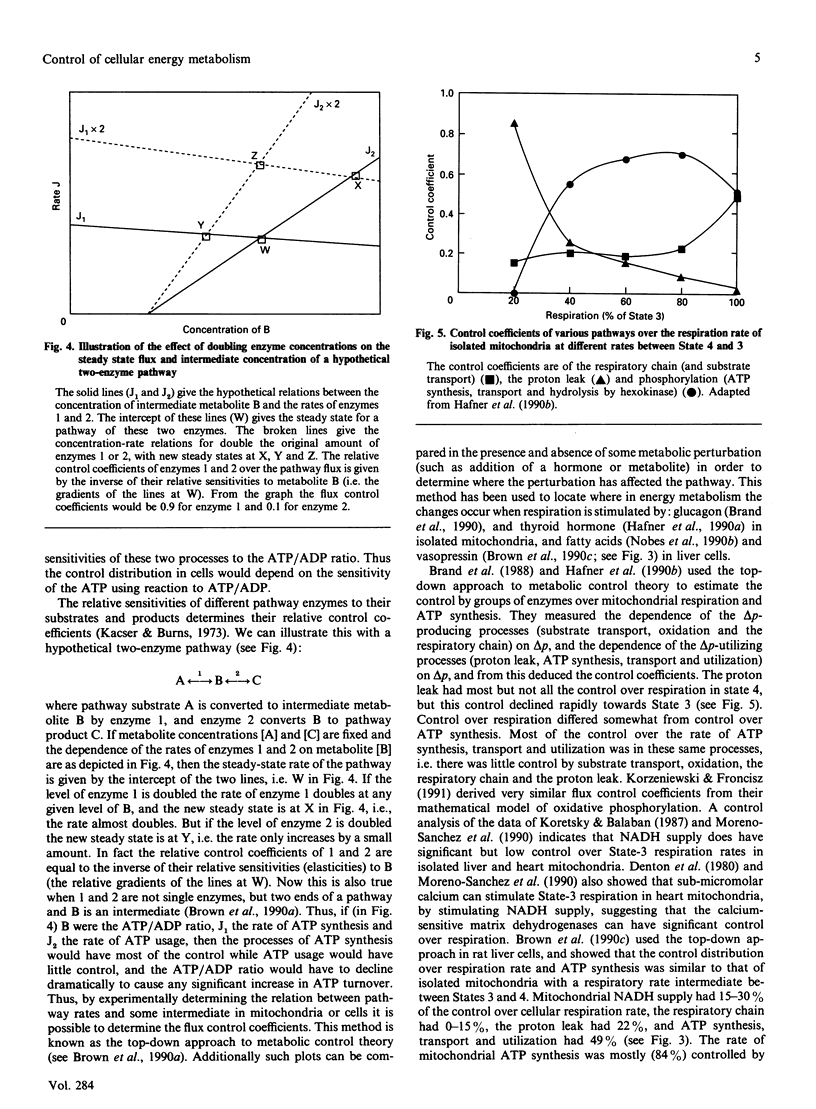
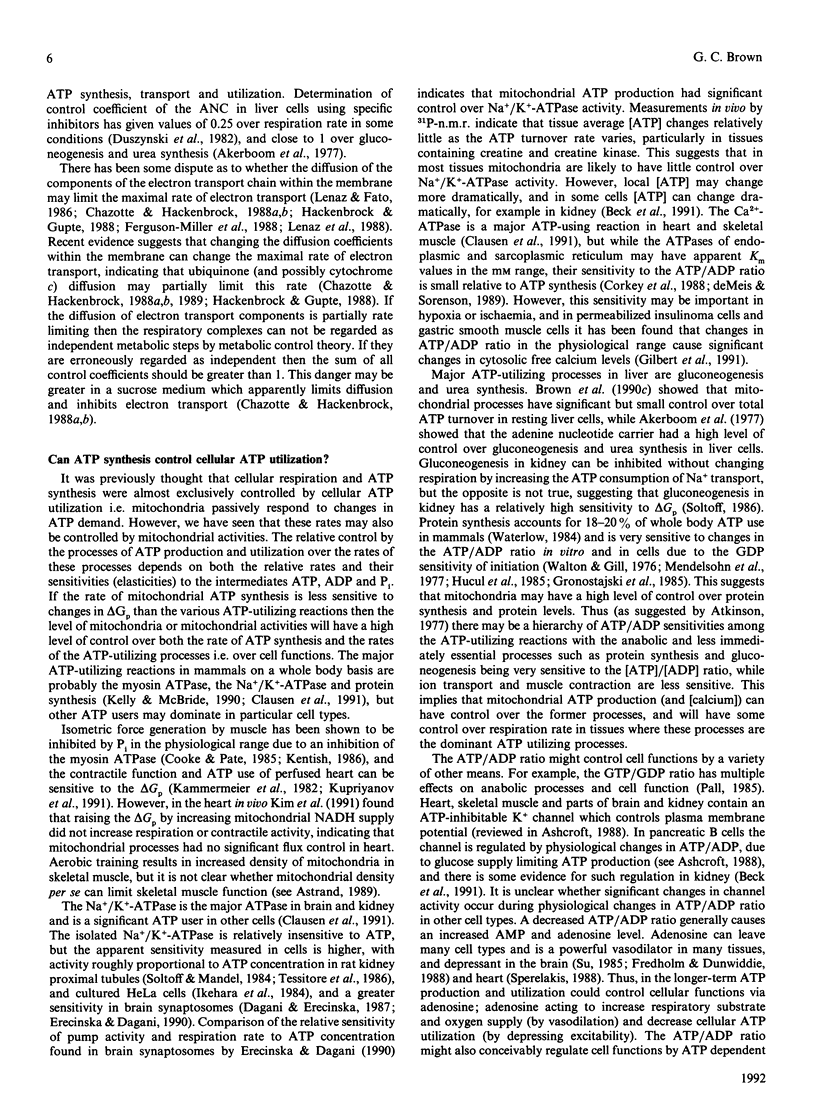

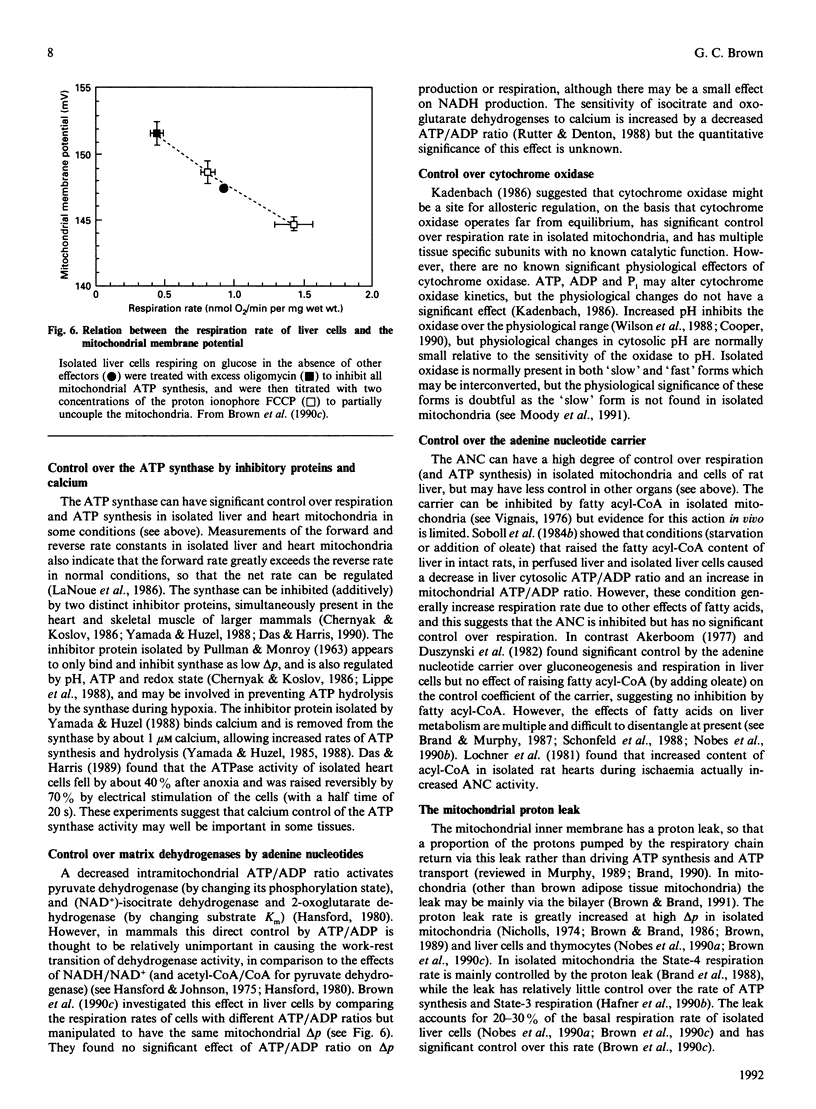
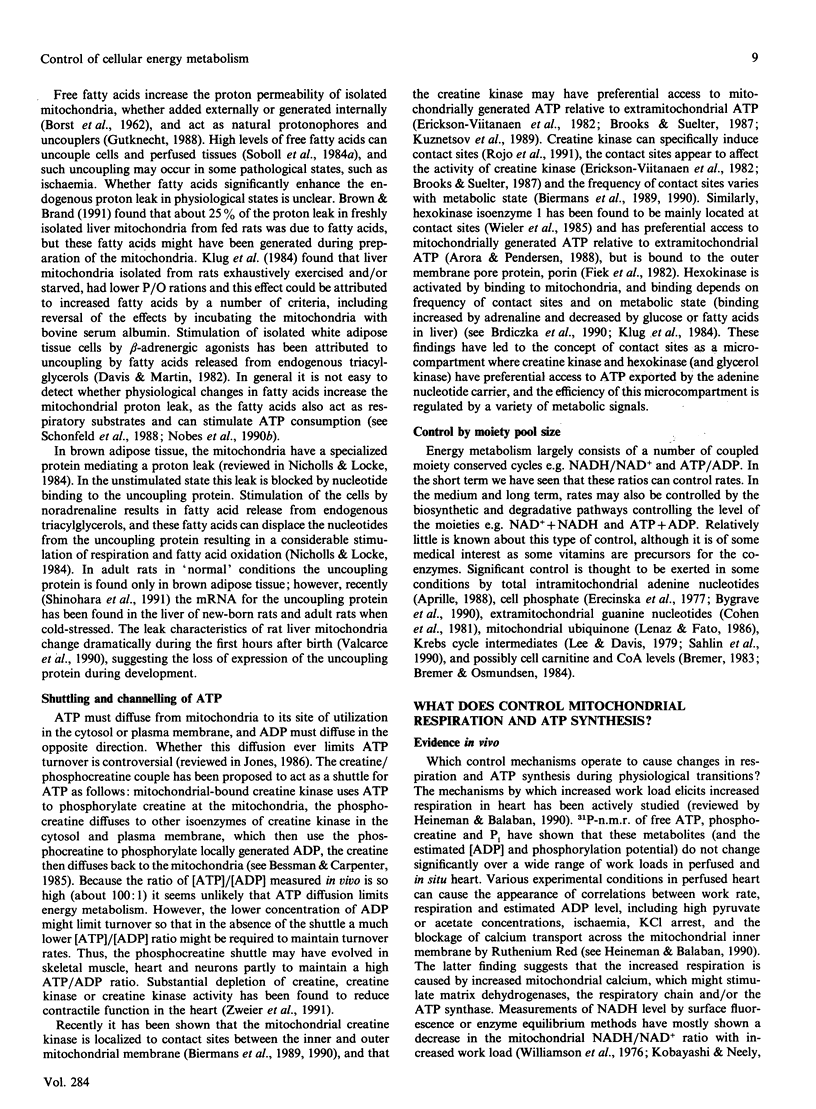
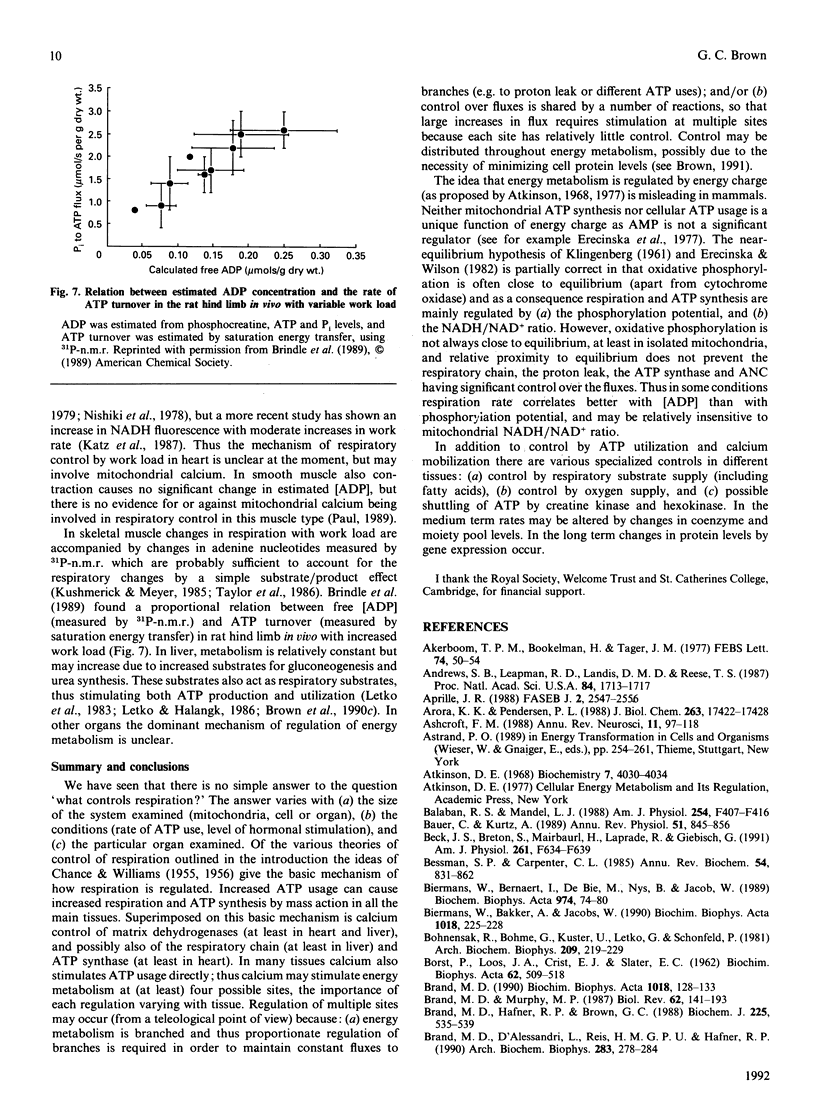
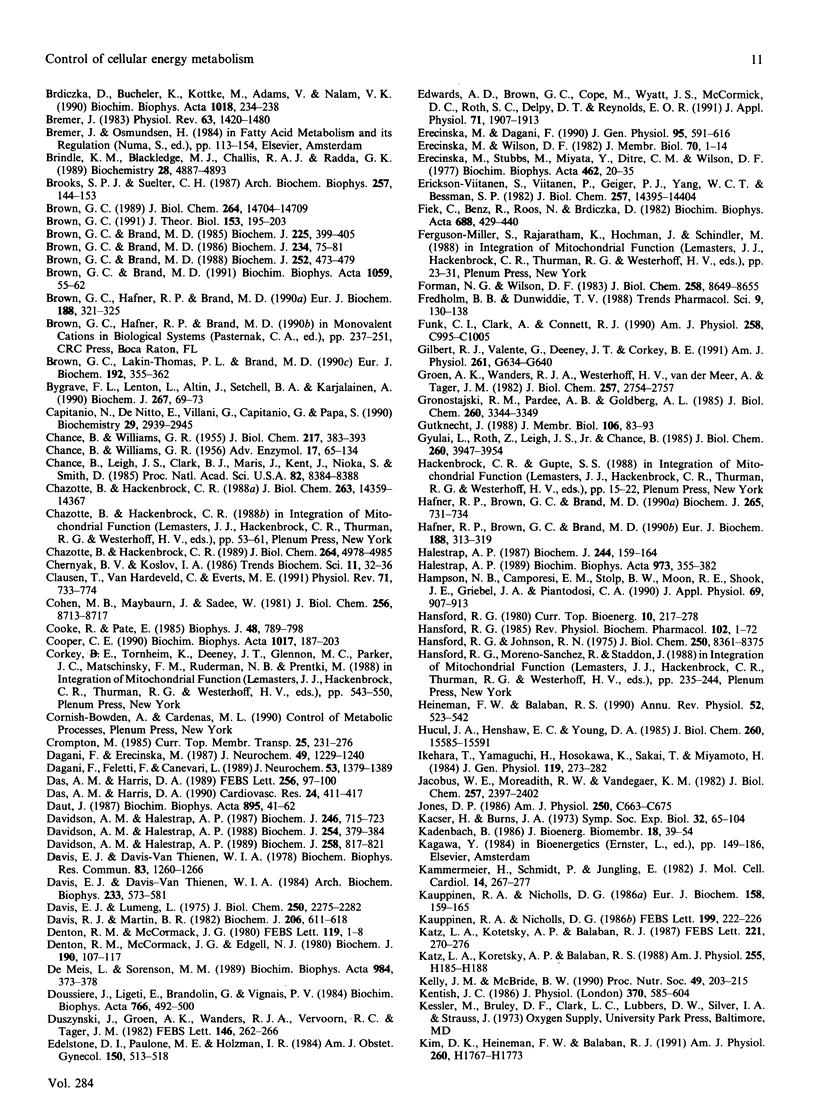
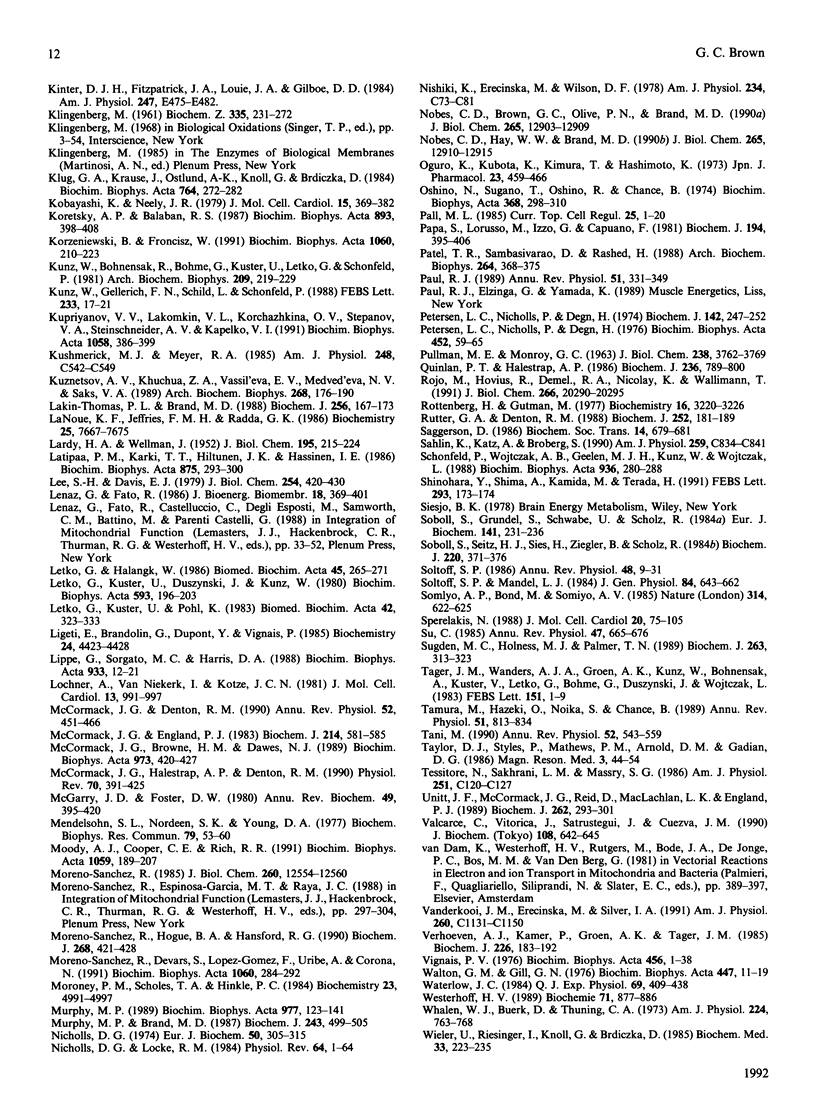
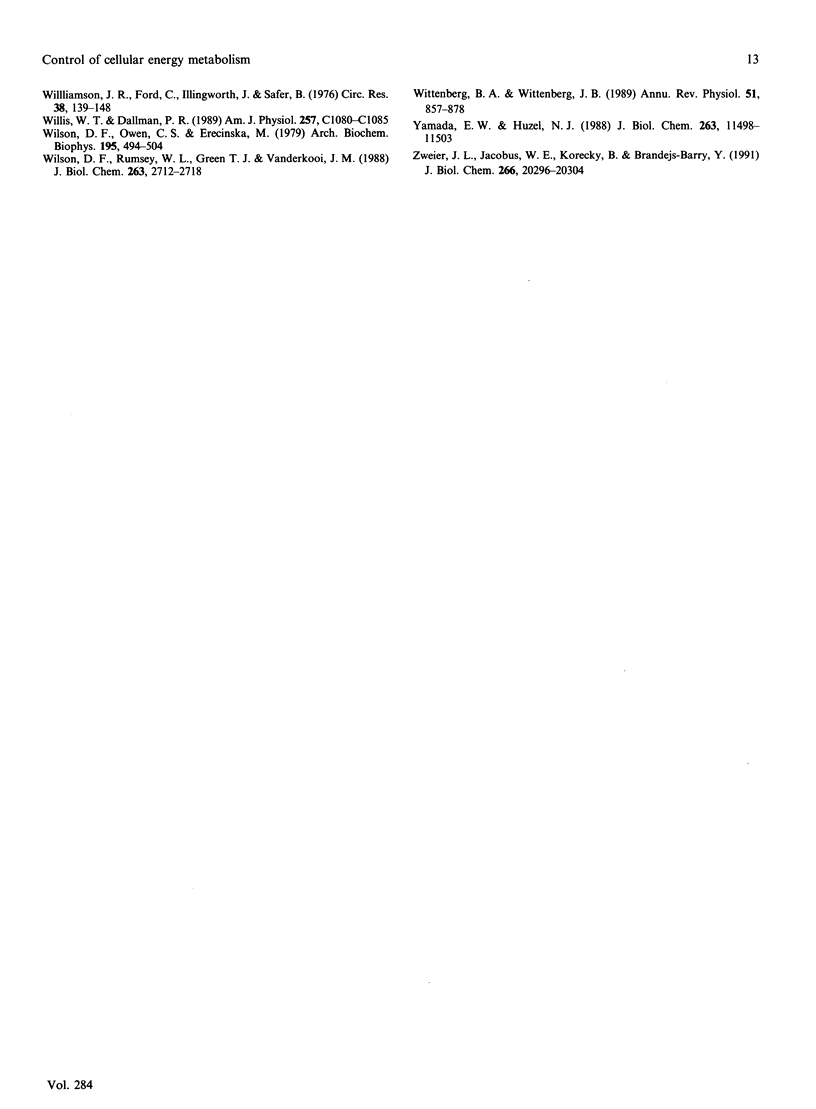
Images in this article
Selected References
These references are in PubMed. This may not be the complete list of references from this article.
- Akerboom T. P., Bookelman H., Tager J. M. Control of ATP transport across the mitochondrial membrane in isolated rat-liver cells. FEBS Lett. 1977 Feb 15;74(1):50–54. doi: 10.1016/0014-5793(77)80750-3. [DOI] [PubMed] [Google Scholar]
- Andrews S. B., Leapman R. D., Landis D. M., Reese T. S. Distribution of calcium and potassium in presynaptic nerve terminals from cerebellar cortex. Proc Natl Acad Sci U S A. 1987 Mar;84(6):1713–1717. doi: 10.1073/pnas.84.6.1713. [DOI] [PMC free article] [PubMed] [Google Scholar]
- Aprille J. R. Regulation of the mitochondrial adenine nucleotide pool size in liver: mechanism and metabolic role. FASEB J. 1988 Jul;2(10):2547–2556. doi: 10.1096/fasebj.2.10.3290024. [DOI] [PubMed] [Google Scholar]
- Arora K. K., Pedersen P. L. Functional significance of mitochondrial bound hexokinase in tumor cell metabolism. Evidence for preferential phosphorylation of glucose by intramitochondrially generated ATP. J Biol Chem. 1988 Nov 25;263(33):17422–17428. [PubMed] [Google Scholar]
- Ashcroft F. M. Adenosine 5'-triphosphate-sensitive potassium channels. Annu Rev Neurosci. 1988;11:97–118. doi: 10.1146/annurev.ne.11.030188.000525. [DOI] [PubMed] [Google Scholar]
- Atkinson D. E. The energy charge of the adenylate pool as a regulatory parameter. Interaction with feedback modifiers. Biochemistry. 1968 Nov;7(11):4030–4034. doi: 10.1021/bi00851a033. [DOI] [PubMed] [Google Scholar]
- BORST P., LOOS J. A., CHRIST E. J., SLATER E. C. Uncoupling activity of long-chain fatty acids. Biochim Biophys Acta. 1962 Aug 27;62:509–518. doi: 10.1016/0006-3002(62)90232-9. [DOI] [PubMed] [Google Scholar]
- Balaban R. S., Mandel L. J. Metabolic substrate utilization by rabbit proximal tubule. An NADH fluorescence study. Am J Physiol. 1988 Mar;254(3 Pt 2):F407–F416. doi: 10.1152/ajprenal.1988.254.3.F407. [DOI] [PubMed] [Google Scholar]
- Bauer C., Kurtz A. Oxygen sensing in the kidney and its relation to erythropoietin production. Annu Rev Physiol. 1989;51:845–856. doi: 10.1146/annurev.ph.51.030189.004213. [DOI] [PubMed] [Google Scholar]
- Beck J. S., Breton S., Mairbäurl H., Laprade R., Giebisch G. Relationship between sodium transport and intracellular ATP in isolated perfused rabbit proximal convoluted tubule. Am J Physiol. 1991 Oct;261(4 Pt 2):F634–F639. doi: 10.1152/ajprenal.1991.261.4.F634. [DOI] [PubMed] [Google Scholar]
- Bessman S. P., Carpenter C. L. The creatine-creatine phosphate energy shuttle. Annu Rev Biochem. 1985;54:831–862. doi: 10.1146/annurev.bi.54.070185.004151. [DOI] [PubMed] [Google Scholar]
- Biermans W., Bakker A., Jacob W. Contact site between inner and outer mitochondrial membrane: a dynamic microcompartment for creatine kinase activity. Biochim Biophys Acta. 1990 Jul 25;1018(2-3):225–228. doi: 10.1016/0005-2728(90)90254-2. [DOI] [PubMed] [Google Scholar]
- Biermans W., Bernaert I., De Bie M., Nijs B., Jacob W. Ultrastructural localisation of creatine kinase activity in the contact sites between inner and outer mitochondrial membranes of rat myocardium. Biochim Biophys Acta. 1989 Apr 17;974(1):74–80. doi: 10.1016/s0005-2728(89)80167-7. [DOI] [PubMed] [Google Scholar]
- Brand M. D., D'Alessandri L., Reis H. M., Hafner R. P. Stimulation of the electron transport chain in mitochondria isolated from rats treated with mannoheptulose or glucagon. Arch Biochem Biophys. 1990 Dec;283(2):278–284. doi: 10.1016/0003-9861(90)90643-d. [DOI] [PubMed] [Google Scholar]
- Brand M. D., Hafner R. P., Brown G. C. Control of respiration in non-phosphorylating mitochondria is shared between the proton leak and the respiratory chain. Biochem J. 1988 Oct 15;255(2):535–539. [PMC free article] [PubMed] [Google Scholar]
- Brand M. D., Murphy M. P. Control of electron flux through the respiratory chain in mitochondria and cells. Biol Rev Camb Philos Soc. 1987 May;62(2):141–193. doi: 10.1111/j.1469-185x.1987.tb01265.x. [DOI] [PubMed] [Google Scholar]
- Brand M. D. The proton leak across the mitochondrial inner membrane. Biochim Biophys Acta. 1990 Jul 25;1018(2-3):128–133. doi: 10.1016/0005-2728(90)90232-s. [DOI] [PubMed] [Google Scholar]
- Brdiczka D., Bücheler K., Kottke M., Adams V., Nalam V. K. Characterization and metabolic function of mitochondrial contact sites. Biochim Biophys Acta. 1990 Jul 25;1018(2-3):234–238. doi: 10.1016/0005-2728(90)90256-4. [DOI] [PubMed] [Google Scholar]
- Bremer J. Carnitine--metabolism and functions. Physiol Rev. 1983 Oct;63(4):1420–1480. doi: 10.1152/physrev.1983.63.4.1420. [DOI] [PubMed] [Google Scholar]
- Brindle K. M., Blackledge M. J., Challiss R. A., Radda G. K. 31P NMR magnetization-transfer measurements of ATP turnover during steady-state isometric muscle contraction in the rat hind limb in vivo. Biochemistry. 1989 May 30;28(11):4887–4893. doi: 10.1021/bi00437a054. [DOI] [PubMed] [Google Scholar]
- Brooks S. P., Suelter C. H. Compartmented coupling of chicken heart mitochondrial creatine kinase to the nucleotide translocase requires the outer mitochondrial membrane. Arch Biochem Biophys. 1987 Aug 15;257(1):144–153. doi: 10.1016/0003-9861(87)90553-4. [DOI] [PubMed] [Google Scholar]
- Brown G. C., Brand M. D. Changes in permeability to protons and other cations at high proton motive force in rat liver mitochondria. Biochem J. 1986 Feb 15;234(1):75–81. doi: 10.1042/bj2340075. [DOI] [PMC free article] [PubMed] [Google Scholar]
- Brown G. C., Brand M. D. On the nature of the mitochondrial proton leak. Biochim Biophys Acta. 1991 Aug 2;1059(1):55–62. doi: 10.1016/s0005-2728(05)80187-2. [DOI] [PubMed] [Google Scholar]
- Brown G. C., Brand M. D. Proton/electron stoichiometry of mitochondrial complex I estimated from the equilibrium thermodynamic force ratio. Biochem J. 1988 Jun 1;252(2):473–479. doi: 10.1042/bj2520473. [DOI] [PMC free article] [PubMed] [Google Scholar]
- Brown G. C., Brand M. D. Thermodynamic control of electron flux through mitochondrial cytochrome bc1 complex. Biochem J. 1985 Jan 15;225(2):399–405. doi: 10.1042/bj2250399. [DOI] [PMC free article] [PubMed] [Google Scholar]
- Brown G. C., Hafner R. P., Brand M. D. A 'top-down' approach to the determination of control coefficients in metabolic control theory. Eur J Biochem. 1990 Mar 10;188(2):321–325. doi: 10.1111/j.1432-1033.1990.tb15406.x. [DOI] [PubMed] [Google Scholar]
- Brown G. C., Lakin-Thomas P. L., Brand M. D. Control of respiration and oxidative phosphorylation in isolated rat liver cells. Eur J Biochem. 1990 Sep 11;192(2):355–362. doi: 10.1111/j.1432-1033.1990.tb19234.x. [DOI] [PubMed] [Google Scholar]
- Brown G. C. The relative proton stoichiometries of the mitochondrial proton pumps are independent of the proton motive force. J Biol Chem. 1989 Sep 5;264(25):14704–14709. [PubMed] [Google Scholar]
- Brown G. C. Total cell protein concentration as an evolutionary constraint on the metabolic control distribution in cells. J Theor Biol. 1991 Nov 21;153(2):195–203. doi: 10.1016/s0022-5193(05)80422-9. [DOI] [PubMed] [Google Scholar]
- Bygrave F. L., Lenton L., Altin J. G., Setchell B. A., Karjalainen A. Phosphate and calcium uptake by mitochondria and by perfused rat liver induced by the synergistic action of glucagon and vasopressin. Biochem J. 1990 Apr 1;267(1):69–73. doi: 10.1042/bj2670069. [DOI] [PMC free article] [PubMed] [Google Scholar]
- CHANCE B., WILLIAMS G. R. Respiratory enzymes in oxidative phosphorylation. I. Kinetics of oxygen utilization. J Biol Chem. 1955 Nov;217(1):383–393. [PubMed] [Google Scholar]
- CHANCE B., WILLIAMS G. R. The respiratory chain and oxidative phosphorylation. Adv Enzymol Relat Subj Biochem. 1956;17:65–134. doi: 10.1002/9780470122624.ch2. [DOI] [PubMed] [Google Scholar]
- Capitanio N., De Nitto E., Villani G., Capitanio G., Papa S. Protonmotive activity of cytochrome c oxidase: control of oxidoreduction of the heme centers by the protonmotive force in the reconstituted beef heart enzyme. Biochemistry. 1990 Mar 27;29(12):2939–2945. doi: 10.1021/bi00464a008. [DOI] [PubMed] [Google Scholar]
- Chance B., Leigh J. S., Jr, Clark B. J., Maris J., Kent J., Nioka S., Smith D. Control of oxidative metabolism and oxygen delivery in human skeletal muscle: a steady-state analysis of the work/energy cost transfer function. Proc Natl Acad Sci U S A. 1985 Dec;82(24):8384–8388. doi: 10.1073/pnas.82.24.8384. [DOI] [PMC free article] [PubMed] [Google Scholar]
- Chazotte B., Hackenbrock C. R. Lateral diffusion as a rate-limiting step in ubiquinone-mediated mitochondrial electron transport. J Biol Chem. 1989 Mar 25;264(9):4978–4985. [PubMed] [Google Scholar]
- Chazotte B., Hackenbrock C. R. The multicollisional, obstructed, long-range diffusional nature of mitochondrial electron transport. J Biol Chem. 1988 Oct 5;263(28):14359–14367. [PubMed] [Google Scholar]
- Clausen T., Van Hardeveld C., Everts M. E. Significance of cation transport in control of energy metabolism and thermogenesis. Physiol Rev. 1991 Jul;71(3):733–774. doi: 10.1152/physrev.1991.71.3.733. [DOI] [PubMed] [Google Scholar]
- Cohen M. B., Maybaum J., Sadee W. Guanine nucleotide depletion and toxicity in mouse T lymphoma (S-49) cells. J Biol Chem. 1981 Aug 25;256(16):8713–8717. [PubMed] [Google Scholar]
- Cooke R., Pate E. The effects of ADP and phosphate on the contraction of muscle fibers. Biophys J. 1985 Nov;48(5):789–798. doi: 10.1016/S0006-3495(85)83837-6. [DOI] [PMC free article] [PubMed] [Google Scholar]
- Cooper C. E. The steady-state kinetics of cytochrome c oxidation by cytochrome oxidase. Biochim Biophys Acta. 1990 Jun 26;1017(3):187–203. doi: 10.1016/0005-2728(90)90184-6. [DOI] [PubMed] [Google Scholar]
- Dagani F., Erecińska M. Relationships among ATP synthesis, K+ gradients, and neurotransmitter amino acid levels in isolated rat brain synaptosomes. J Neurochem. 1987 Oct;49(4):1229–1240. doi: 10.1111/j.1471-4159.1987.tb10015.x. [DOI] [PubMed] [Google Scholar]
- Dagani F., Feletti F., Canevari L. Effects of diltiazem on bioenergetics, K+ gradients, and free cytosolic Ca2+ levels in rat brain synaptosomes submitted to energy metabolism inhibition and depolarization. J Neurochem. 1989 Nov;53(5):1379–1389. doi: 10.1111/j.1471-4159.1989.tb08528.x. [DOI] [PubMed] [Google Scholar]
- Das A. M., Harris D. A. Control of mitochondrial ATP synthase in heart cells: inactive to active transitions caused by beating or positive inotropic agents. Cardiovasc Res. 1990 May;24(5):411–417. doi: 10.1093/cvr/24.5.411. [DOI] [PubMed] [Google Scholar]
- Das A. M., Harris D. A. Reversible modulation of the mitochondrial ATP synthase with energy demand in cultured rat cardiomyocytes. FEBS Lett. 1989 Oct 9;256(1-2):97–100. doi: 10.1016/0014-5793(89)81725-9. [DOI] [PubMed] [Google Scholar]
- Dauncey M. J. Thyroid hormones and thermogenesis. Proc Nutr Soc. 1990 Jul;49(2):203–215. doi: 10.1079/pns19900024. [DOI] [PubMed] [Google Scholar]
- Daut J. The living cell as an energy-transducing machine. A minimal model of myocardial metabolism. Biochim Biophys Acta. 1987;895(1):41–62. doi: 10.1016/s0304-4173(87)80016-2. [DOI] [PubMed] [Google Scholar]
- Davidson A. M., Halestrap A. P. Inhibition of mitochondrial-matrix inorganic pyrophosphatase by physiological [Ca2+], and its role in the hormonal regulation of mitochondrial matrix volume. Biochem J. 1989 Mar 15;258(3):817–821. doi: 10.1042/bj2580817. [DOI] [PMC free article] [PubMed] [Google Scholar]
- Davidson A. M., Halestrap A. P. Inorganic pyrophosphate is located primarily in the mitochondria of the hepatocyte and increases in parallel with the decrease in light-scattering induced by gluconeogenic hormones, butyrate and ionophore A23187. Biochem J. 1988 Sep 1;254(2):379–384. doi: 10.1042/bj2540379. [DOI] [PMC free article] [PubMed] [Google Scholar]
- Davidson A. M., Halestrap A. P. Liver mitochondrial pyrophosphate concentration is increased by Ca2+ and regulates the intramitochondrial volume and adenine nucleotide content. Biochem J. 1987 Sep 15;246(3):715–723. doi: 10.1042/bj2460715. [DOI] [PMC free article] [PubMed] [Google Scholar]
- Davis E. J., Davis-Van Thienen W. I. Rate control of phosphorylation-coupled respiration by rat liver mitochondria. Arch Biochem Biophys. 1984 Sep;233(2):573–581. doi: 10.1016/0003-9861(84)90481-8. [DOI] [PubMed] [Google Scholar]
- Davis E. J., Davis-van Thienen W. I. Control of mitochondrial metabolism by the ATP/ADP ratio. Biochem Biophys Res Commun. 1978 Aug 29;83(4):1260–1266. doi: 10.1016/0006-291x(78)91357-8. [DOI] [PubMed] [Google Scholar]
- Davis R. J., Martin B. R. The effect of beta-adrenergic agonists on the membrane potential of fat-cell mitochondria in situ. Biochem J. 1982 Sep 15;206(3):611–618. doi: 10.1042/bj2060611. [DOI] [PMC free article] [PubMed] [Google Scholar]
- Denton R. M., McCormack J. G. Ca2+ as a second messenger within mitochondria of the heart and other tissues. Annu Rev Physiol. 1990;52:451–466. doi: 10.1146/annurev.ph.52.030190.002315. [DOI] [PubMed] [Google Scholar]
- Denton R. M., McCormack J. G., Edgell N. J. Role of calcium ions in the regulation of intramitochondrial metabolism. Effects of Na+, Mg2+ and ruthenium red on the Ca2+-stimulated oxidation of oxoglutarate and on pyruvate dehydrogenase activity in intact rat heart mitochondria. Biochem J. 1980 Jul 15;190(1):107–117. doi: 10.1042/bj1900107. [DOI] [PMC free article] [PubMed] [Google Scholar]
- Denton R. M., McCormack J. G. On the role of the calcium transport cycle in heart and other mammalian mitochondria. FEBS Lett. 1980 Sep 22;119(1):1–8. doi: 10.1016/0014-5793(80)80986-0. [DOI] [PubMed] [Google Scholar]
- Doussiere J., Ligeti E., Brandolin G., Vignais P. V. Control of oxidative phosphorylation in rat heart mitochondria. The role of the adenine nucleotide carrier. Biochim Biophys Acta. 1984 Aug 31;766(2):492–500. doi: 10.1016/0005-2728(84)90265-2. [DOI] [PubMed] [Google Scholar]
- Duszynski J., Groen A. K., Wanders R. J., Vervoorn R. C., Tager J. M. Quantification of the role of the adenine nucleotide translocator in the control of mitochondrial respiration in isolated rat-liver cells. FEBS Lett. 1982 Sep 20;146(2):262–266. doi: 10.1016/0014-5793(82)80931-9. [DOI] [PubMed] [Google Scholar]
- Edelstone D. I., Paulone M. E., Holzman I. R. Hepatic oxygenation during arterial hypoxemia in neonatal lambs. Am J Obstet Gynecol. 1984 Nov 1;150(5 Pt 1):513–518. doi: 10.1016/s0002-9378(84)90430-7. [DOI] [PubMed] [Google Scholar]
- Edwards A. D., Brown G. C., Cope M., Wyatt J. S., McCormick D. C., Roth S. C., Delpy D. T., Reynolds E. O. Quantification of concentration changes in neonatal human cerebral oxidized cytochrome oxidase. J Appl Physiol (1985) 1991 Nov;71(5):1907–1913. doi: 10.1152/jappl.1991.71.5.1907. [DOI] [PubMed] [Google Scholar]
- Erecińska M., Dagani F. Relationships between the neuronal sodium/potassium pump and energy metabolism. Effects of K+, Na+, and adenosine triphosphate in isolated brain synaptosomes. J Gen Physiol. 1990 Apr;95(4):591–616. doi: 10.1085/jgp.95.4.591. [DOI] [PMC free article] [PubMed] [Google Scholar]
- Erecińska M., Stubbs M., Miyata Y., Ditre C. M. Regulation of cellular metabolism by intracellular phosphate. Biochim Biophys Acta. 1977 Oct 12;462(1):20–35. doi: 10.1016/0005-2728(77)90186-4. [DOI] [PubMed] [Google Scholar]
- Erecińska M., Wilson D. F. Regulation of cellular energy metabolism. J Membr Biol. 1982;70(1):1–14. doi: 10.1007/BF01871584. [DOI] [PubMed] [Google Scholar]
- Erickson-Viitanen S., Viitanen P., Geiger P. J., Yang W. C., Bessman S. P. Compartmentation of mitochondrial creatine phosphokinase. I. Direct demonstration of compartmentation with the use of labeled precursors. J Biol Chem. 1982 Dec 10;257(23):14395–14404. [PubMed] [Google Scholar]
- Fiek C., Benz R., Roos N., Brdiczka D. Evidence for identity between the hexokinase-binding protein and the mitochondrial porin in the outer membrane of rat liver mitochondria. Biochim Biophys Acta. 1982 Jun 14;688(2):429–440. doi: 10.1016/0005-2736(82)90354-6. [DOI] [PubMed] [Google Scholar]
- Forman N. G., Wilson D. F. Dependence of mitochondrial oxidative phosphorylation on activity of the adenine nucleotide translocase. J Biol Chem. 1983 Jul 25;258(14):8649–8655. [PubMed] [Google Scholar]
- Fredholm B. B., Dunwiddie T. V. How does adenosine inhibit transmitter release? Trends Pharmacol Sci. 1988 Apr;9(4):130–134. doi: 10.1016/0165-6147(88)90194-0. [DOI] [PubMed] [Google Scholar]
- Funk C. I., Clark A., Jr, Connett R. J. A simple model of aerobic metabolism: applications to work transitions in muscle. Am J Physiol. 1990 Jun;258(6 Pt 1):C995–1005. doi: 10.1152/ajpcell.1990.258.6.C995. [DOI] [PubMed] [Google Scholar]
- Gilbert R. J., Valente G., Deeney J. T., Corkey B. E. ATP-dependent control of steady-state cytosolic calcium in cultured gastric smooth muscle. Am J Physiol. 1991 Oct;261(4 Pt 1):G634–G640. doi: 10.1152/ajpgi.1991.261.4.G634. [DOI] [PubMed] [Google Scholar]
- Groen A. K., Wanders R. J., Westerhoff H. V., van der Meer R., Tager J. M. Quantification of the contribution of various steps to the control of mitochondrial respiration. J Biol Chem. 1982 Mar 25;257(6):2754–2757. [PubMed] [Google Scholar]
- Gronostajski R. M., Pardee A. B., Goldberg A. L. The ATP dependence of the degradation of short- and long-lived proteins in growing fibroblasts. J Biol Chem. 1985 Mar 25;260(6):3344–3349. [PubMed] [Google Scholar]
- Gutknecht J. Proton conductance caused by long-chain fatty acids in phospholipid bilayer membranes. J Membr Biol. 1988 Nov;106(1):83–93. doi: 10.1007/BF01871769. [DOI] [PubMed] [Google Scholar]
- Gyulai L., Roth Z., Leigh J. S., Jr, Chance B. Bioenergetic studies of mitochondrial oxidative phosphorylation using 31phosphorus NMR. J Biol Chem. 1985 Apr 10;260(7):3947–3954. [PubMed] [Google Scholar]
- Hafner R. P., Brown G. C., Brand M. D. Analysis of the control of respiration rate, phosphorylation rate, proton leak rate and protonmotive force in isolated mitochondria using the 'top-down' approach of metabolic control theory. Eur J Biochem. 1990 Mar 10;188(2):313–319. doi: 10.1111/j.1432-1033.1990.tb15405.x. [DOI] [PubMed] [Google Scholar]
- Hafner R. P., Brown G. C., Brand M. D. Thyroid-hormone control of state-3 respiration in isolated rat liver mitochondria. Biochem J. 1990 Feb 1;265(3):731–734. doi: 10.1042/bj2650731. [DOI] [PMC free article] [PubMed] [Google Scholar]
- Halestrap A. P. The regulation of the matrix volume of mammalian mitochondria in vivo and in vitro and its role in the control of mitochondrial metabolism. Biochim Biophys Acta. 1989 Mar 23;973(3):355–382. doi: 10.1016/s0005-2728(89)80378-0. [DOI] [PubMed] [Google Scholar]
- Halestrap A. P. The regulation of the oxidation of fatty acids and other substrates in rat heart mitochondria by changes in the matrix volume induced by osmotic strength, valinomycin and Ca2+. Biochem J. 1987 May 15;244(1):159–164. doi: 10.1042/bj2440159. [DOI] [PMC free article] [PubMed] [Google Scholar]
- Hampson N. B., Camporesi E. M., Stolp B. W., Moon R. E., Shook J. E., Griebel J. A., Piantadosi C. A. Cerebral oxygen availability by NIR spectroscopy during transient hypoxia in humans. J Appl Physiol (1985) 1990 Sep;69(3):907–913. doi: 10.1152/jappl.1990.69.3.907. [DOI] [PubMed] [Google Scholar]
- Hansford R. G., Johnson R. N. The steady state concentrations of coenzyme A-SH and coenzyme A thioester, citrate, and isocitrate during tricarboxylate cycle oxidations in rabbit heart mitochondria. J Biol Chem. 1975 Nov 10;250(21):8361–8375. [PubMed] [Google Scholar]
- Hansford R. G. Relation between mitochondrial calcium transport and control of energy metabolism. Rev Physiol Biochem Pharmacol. 1985;102:1–72. doi: 10.1007/BFb0034084. [DOI] [PubMed] [Google Scholar]
- Heineman F. W., Balaban R. S. Control of mitochondrial respiration in the heart in vivo. Annu Rev Physiol. 1990;52:523–542. doi: 10.1146/annurev.ph.52.030190.002515. [DOI] [PubMed] [Google Scholar]
- Hucul J. A., Henshaw E. C., Young D. A. Nucleoside diphosphate regulation of overall rates of protein biosynthesis acting at the level of initiation. J Biol Chem. 1985 Dec 15;260(29):15585–15591. [PubMed] [Google Scholar]
- Ikehara T., Yamaguchi H., Hosokawa K., Sakai T., Miyamoto H. Rb+ influx in response to changes in energy generation: effect of the regulation of the ATP content of HeLa cells. J Cell Physiol. 1984 Jun;119(3):273–282. doi: 10.1002/jcp.1041190305. [DOI] [PubMed] [Google Scholar]
- Jacobus W. E., Moreadith R. W., Vandegaer K. M. Mitochondrial respiratory control. Evidence against the regulation of respiration by extramitochondrial phosphorylation potentials or by [ATP]/[ADP] ratios. J Biol Chem. 1982 Mar 10;257(5):2397–2402. [PubMed] [Google Scholar]
- Jones D. P. Intracellular diffusion gradients of O2 and ATP. Am J Physiol. 1986 May;250(5 Pt 1):C663–C675. doi: 10.1152/ajpcell.1986.250.5.C663. [DOI] [PubMed] [Google Scholar]
- KLINGENBERG M. [On the reversibility of oxidative phosphorylation. IV. Relation between the redox state of cytochrome c and the phosphorylation potential of adenosine triphosphate]. Biochem Z. 1961;335:263–272. [PubMed] [Google Scholar]
- Kacser H., Burns J. A. The control of flux. Symp Soc Exp Biol. 1973;27:65–104. [PubMed] [Google Scholar]
- Kadenbach B. Regulation of respiration and ATP synthesis in higher organisms: hypothesis. J Bioenerg Biomembr. 1986 Feb;18(1):39–54. doi: 10.1007/BF00743611. [DOI] [PubMed] [Google Scholar]
- Kammermeier H., Schmidt P., Jüngling E. Free energy change of ATP-hydrolysis: a causal factor of early hypoxic failure of the myocardium? J Mol Cell Cardiol. 1982 May;14(5):267–277. doi: 10.1016/0022-2828(82)90205-x. [DOI] [PubMed] [Google Scholar]
- Katz L. A., Koretsky A. P., Balaban R. S. Activation of dehydrogenase activity and cardiac respiration: a 31P-NMR study. Am J Physiol. 1988 Jul;255(1 Pt 2):H185–H188. doi: 10.1152/ajpheart.1988.255.1.H185. [DOI] [PubMed] [Google Scholar]
- Katz L. A., Koretsky A. P., Balaban R. S. Respiratory control in the glucose perfused heart. A 31P NMR and NADH fluorescence study. FEBS Lett. 1987 Sep 14;221(2):270–276. doi: 10.1016/0014-5793(87)80939-0. [DOI] [PubMed] [Google Scholar]
- Kauppinen R. A., Nicholls D. G. Pyruvate utilization by synaptosomes is independent of calcium. FEBS Lett. 1986 Apr 21;199(2):222–226. doi: 10.1016/0014-5793(86)80484-7. [DOI] [PubMed] [Google Scholar]
- Kauppinen R. A., Nicholls D. G. Synaptosomal bioenergetics. The role of glycolysis, pyruvate oxidation and responses to hypoglycaemia. Eur J Biochem. 1986 Jul 1;158(1):159–165. doi: 10.1111/j.1432-1033.1986.tb09733.x. [DOI] [PubMed] [Google Scholar]
- Kentish J. C. The effects of inorganic phosphate and creatine phosphate on force production in skinned muscles from rat ventricle. J Physiol. 1986 Jan;370:585–604. doi: 10.1113/jphysiol.1986.sp015952. [DOI] [PMC free article] [PubMed] [Google Scholar]
- Kim D. K., Heineman F. W., Balaban R. S. Effects of beta-hydroxybutyrate on oxidative metabolism and phosphorylation potential in canine heart in vivo. Am J Physiol. 1991 Jun;260(6 Pt 2):H1767–H1773. doi: 10.1152/ajpheart.1991.260.6.H1767. [DOI] [PubMed] [Google Scholar]
- Kintner D., Fitzpatrick J. H., Jr, Louie J. A., Gilboe D. D. Cerebral oxygen and energy metabolism during and after 30 minutes of moderate hypoxia. Am J Physiol. 1984 Oct;247(4 Pt 1):E475–E482. doi: 10.1152/ajpendo.1984.247.4.E475. [DOI] [PubMed] [Google Scholar]
- Klug G. A., Krause J., Ostlund A. K., Knoll G., Brdiczka D. Alterations in liver mitochondrial function as a result of fasting and exhaustive exercise. Biochim Biophys Acta. 1984 Mar 30;764(3):272–282. doi: 10.1016/0005-2728(84)90097-5. [DOI] [PubMed] [Google Scholar]
- Kobayashi K., Neely J. R. Mechanism of pyruvate dehydrogenase activation by increased cardiac work. J Mol Cell Cardiol. 1983 Jun;15(6):369–382. doi: 10.1016/0022-2828(83)90321-8. [DOI] [PubMed] [Google Scholar]
- Koretsky A. P., Balaban R. S. Changes in pyridine nucleotide levels alter oxygen consumption and extra-mitochondrial phosphates in isolated mitochondria: a 31P-NMR and NAD(P)H fluorescence study. Biochim Biophys Acta. 1987 Oct 7;893(3):398–408. doi: 10.1016/0005-2728(87)90092-2. [DOI] [PubMed] [Google Scholar]
- Korzeniewski B., Froncisz W. An extended dynamic model of oxidative phosphorylation. Biochim Biophys Acta. 1991 Oct 18;1060(2):210–223. doi: 10.1016/s0005-2728(09)91009-x. [DOI] [PubMed] [Google Scholar]
- Kunz W., Bohnensack R., Böhme G., Küster U., Letko G., Schönfeld P. Relations between extramitochondrial and intramitochondrial adenine nucleotide systems. Arch Biochem Biophys. 1981 Jun;209(1):219–229. doi: 10.1016/0003-9861(81)90274-5. [DOI] [PubMed] [Google Scholar]
- Kunz W., Bohnensack R., Böhme G., Küster U., Letko G., Schönfeld P. Relations between extramitochondrial and intramitochondrial adenine nucleotide systems. Arch Biochem Biophys. 1981 Jun;209(1):219–229. doi: 10.1016/0003-9861(81)90274-5. [DOI] [PubMed] [Google Scholar]
- Kunz W., Gellerich F. N., Schild L., Schönfeld P. Kinetic limitations in the overall reaction of mitochondrial oxidative phosphorylation accounting for flux-dependent changes in the apparent delta GexP/delta mu H+ ratio. FEBS Lett. 1988 Jun 6;233(1):17–21. doi: 10.1016/0014-5793(88)81347-4. [DOI] [PubMed] [Google Scholar]
- Kupriyanov V. V., Lakomkin V. L., Korchazhkina O. V., Stepanov V. A., Steinschneider AYa, Kapelko V. I. Cardiac contractile function, oxygen consumption rate and cytosolic phosphates during inhibition of electron flux by amytal--a 31P-NMR study. Biochim Biophys Acta. 1991 Jul 5;1058(3):386–399. doi: 10.1016/s0005-2728(05)80135-5. [DOI] [PubMed] [Google Scholar]
- Kushmerick M. J., Meyer R. A. Chemical changes in rat leg muscle by phosphorus nuclear magnetic resonance. Am J Physiol. 1985 May;248(5 Pt 1):C542–C549. doi: 10.1152/ajpcell.1985.248.5.C542. [DOI] [PubMed] [Google Scholar]
- Kuznetsov A. V., Khuchua Z. A., Vassil'eva E. V., Medved'eva N. V., Saks V. A. Heart mitochondrial creatine kinase revisited: the outer mitochondrial membrane is not important for coupling of phosphocreatine production to oxidative phosphorylation. Arch Biochem Biophys. 1989 Jan;268(1):176–190. doi: 10.1016/0003-9861(89)90578-x. [DOI] [PubMed] [Google Scholar]
- LARDY H. A., WELLMAN H. Oxidative phosphorylations; rôle of inorganic phosphate and acceptor systems in control of metabolic rates. J Biol Chem. 1952 Mar;195(1):215–224. [PubMed] [Google Scholar]
- LaNoue K. F., Jeffries F. M., Radda G. K. Kinetic control of mitochondrial ATP synthesis. Biochemistry. 1986 Nov 18;25(23):7667–7675. doi: 10.1021/bi00371a058. [DOI] [PubMed] [Google Scholar]
- Lakin-Thomas P. L., Brand M. D. Stimulation of respiration by mitogens in rat thymocytes is independent of mitochondrial calcium. Biochem J. 1988 Nov 15;256(1):167–173. doi: 10.1042/bj2560167. [DOI] [PMC free article] [PubMed] [Google Scholar]
- Latipä P. M., Kärki T. T., Hiltunen J. K., Hassinen I. E. Regulation of palmitoylcarnitine oxidation in isolated rat liver mitochondria. Role of the redox state of NAD(H). Biochim Biophys Acta. 1986 Feb 12;875(2):293–300. doi: 10.1016/0005-2760(86)90179-7. [DOI] [PubMed] [Google Scholar]
- Lee S. H., Davis E. J. Carboxylation and decarboxylation reactions. Anaplerotic flux and removal of citrate cycle intermediates in skeletal muscle. J Biol Chem. 1979 Jan 25;254(2):420–430. [PubMed] [Google Scholar]
- Lenaz G., Fato R. Is ubiquinone diffusion rate-limiting for electron transfer? J Bioenerg Biomembr. 1986 Oct;18(5):369–401. doi: 10.1007/BF00743011. [DOI] [PubMed] [Google Scholar]
- Letko G., Halangk W. Effect of improved hydrogen supply on energy state, ureogenesis and gluconeogenesis in isolated hepatocytes. Biomed Biochim Acta. 1986;45(3):265–271. [PubMed] [Google Scholar]
- Letko G., Küster U., Duszyński J., Kunz W. Investigation of the dependence of the intramitochondrial [ATP]/[ADP] ratio on the respiration rate. Biochim Biophys Acta. 1980 Dec 3;593(2):196–203. doi: 10.1016/0005-2728(80)90057-2. [DOI] [PubMed] [Google Scholar]
- Letko G., Küster U., Pohl K. Influence of precursors of biosyntheses on the energy metabolism of the liver cell. Biomed Biochim Acta. 1983;42(4):323–333. [PubMed] [Google Scholar]
- Ligeti E., Brandolin G., Dupont Y., Vignais P. V. Kinetics of Pi-Pi exchange in rat liver mitochondria. Rapid filtration experiments in the millisecond time range. Biochemistry. 1985 Jul 30;24(16):4423–4428. doi: 10.1021/bi00337a025. [DOI] [PubMed] [Google Scholar]
- Lippe G., Sorgato M. C., Harris D. A. The binding and release of the inhibitor protein are governed independently by ATP and membrane potential in ox-heart submitochondrial vesicles. Biochim Biophys Acta. 1988 Mar 30;933(1):12–21. doi: 10.1016/0005-2728(88)90051-5. [DOI] [PubMed] [Google Scholar]
- Lochner A., Van Niekerk I., Kotzé J. C. Mitochondrial acyl-CoA, adenine nucleotide translocase activity and oxidative phosphorylation in myocardial ischaemia. J Mol Cell Cardiol. 1981 Nov;13(11):991–997. doi: 10.1016/0022-2828(81)90474-0. [DOI] [PubMed] [Google Scholar]
- McCormack J. G., Browne H. M., Dawes N. J. Studies on mitochondrial Ca2+-transport and matrix Ca2+ using fura-2-loaded rat heart mitochondria. Biochim Biophys Acta. 1989 Mar 23;973(3):420–427. doi: 10.1016/s0005-2728(89)80384-6. [DOI] [PubMed] [Google Scholar]
- McCormack J. G., England P. J. Ruthenium Red inhibits the activation of pyruvate dehydrogenase caused by positive inotropic agents in the perfused rat heart. Biochem J. 1983 Aug 15;214(2):581–585. doi: 10.1042/bj2140581. [DOI] [PMC free article] [PubMed] [Google Scholar]
- McCormack J. G., Halestrap A. P., Denton R. M. Role of calcium ions in regulation of mammalian intramitochondrial metabolism. Physiol Rev. 1990 Apr;70(2):391–425. doi: 10.1152/physrev.1990.70.2.391. [DOI] [PubMed] [Google Scholar]
- McGarry J. D., Foster D. W. Regulation of hepatic fatty acid oxidation and ketone body production. Annu Rev Biochem. 1980;49:395–420. doi: 10.1146/annurev.bi.49.070180.002143. [DOI] [PubMed] [Google Scholar]
- Mendelsohn S. L., Nordeen S. K., Young D. A. Rapid changes in initiation-limited rates of protein synthesis in rat thymic lymphocytes correlate with energy charge. Biochem Biophys Res Commun. 1977 Nov 7;79(1):53–60. doi: 10.1016/0006-291x(77)90059-6. [DOI] [PubMed] [Google Scholar]
- Moody A. J., Cooper C. E., Rich P. R. Characterisation of 'fast' and 'slow' forms of bovine heart cytochrome-c oxidase. Biochim Biophys Acta. 1991 Aug 23;1059(2):189–207. doi: 10.1016/s0005-2728(05)80204-x. [DOI] [PubMed] [Google Scholar]
- Moreno-Sánchez R. Contribution of the translocator of adenine nucleotides and the ATP synthase to the control of oxidative phosphorylation and arsenylation in liver mitochondria. J Biol Chem. 1985 Oct 15;260(23):12554–12560. [PubMed] [Google Scholar]
- Moreno-Sánchez R., Devars S., López-Gómez F., Uribe A., Corona N. Distribution of control of oxidative phosphorylation in mitochondria oxidizing NAD-linked substrates. Biochim Biophys Acta. 1991 Nov 7;1060(3):284–292. doi: 10.1016/s0005-2728(05)80318-4. [DOI] [PubMed] [Google Scholar]
- Moreno-Sánchez R., Hogue B. A., Hansford R. G. Influence of NAD-linked dehydrogenase activity on flux through oxidative phosphorylation. Biochem J. 1990 Jun 1;268(2):421–428. doi: 10.1042/bj2680421. [DOI] [PMC free article] [PubMed] [Google Scholar]
- Moroney P. M., Scholes T. A., Hinkle P. C. Effect of membrane potential and pH gradient on electron transfer in cytochrome oxidase. Biochemistry. 1984 Oct 9;23(21):4991–4997. doi: 10.1021/bi00316a025. [DOI] [PubMed] [Google Scholar]
- Murphy M. P., Brand M. D. The control of electron flux through cytochrome oxidase. Biochem J. 1987 Apr 15;243(2):499–505. doi: 10.1042/bj2430499. [DOI] [PMC free article] [PubMed] [Google Scholar]
- Murphy M. P. Slip and leak in mitochondrial oxidative phosphorylation. Biochim Biophys Acta. 1989 Nov 23;977(2):123–141. doi: 10.1016/s0005-2728(89)80063-5. [DOI] [PubMed] [Google Scholar]
- Nicholls D. G., Locke R. M. Thermogenic mechanisms in brown fat. Physiol Rev. 1984 Jan;64(1):1–64. doi: 10.1152/physrev.1984.64.1.1. [DOI] [PubMed] [Google Scholar]
- Nicholls D. G. The influence of respiration and ATP hydrolysis on the proton-electrochemical gradient across the inner membrane of rat-liver mitochondria as determined by ion distribution. Eur J Biochem. 1974 Dec 16;50(1):305–315. doi: 10.1111/j.1432-1033.1974.tb03899.x. [DOI] [PubMed] [Google Scholar]
- Nishiki K., Erecińska M., Wilson D. F. Energy relationships between cytosolic metabolism and mitochondrial respiration in rat heart. Am J Physiol. 1978 Mar;234(3):C73–C81. doi: 10.1152/ajpcell.1978.234.3.C73. [DOI] [PubMed] [Google Scholar]
- Nobes C. D., Brown G. C., Olive P. N., Brand M. D. Non-ohmic proton conductance of the mitochondrial inner membrane in hepatocytes. J Biol Chem. 1990 Aug 5;265(22):12903–12909. [PubMed] [Google Scholar]
- Nobes C. D., Hay W. W., Jr, Brand M. D. The mechanism of stimulation of respiration by fatty acids in isolated hepatocytes. J Biol Chem. 1990 Aug 5;265(22):12910–12915. [PubMed] [Google Scholar]
- Oguro K., Kubota K., Kimura T., Hashimoto K. Effects of various coronary vasodilators on myocardial oxygen consumption. Jpn J Pharmacol. 1973 Aug;23(4):459–466. doi: 10.1254/jjp.23.459. [DOI] [PubMed] [Google Scholar]
- Oshino N., Sugano T., Oshino R., Chance B. Mitochondrial function under hypoxic conditions: the steady states of cytochrome alpha+alpha3 and their relation to mitochondrial energy states. Biochim Biophys Acta. 1974 Dec 19;368(3):298–310. doi: 10.1016/0005-2728(74)90176-5. [DOI] [PubMed] [Google Scholar]
- PULLMAN M. E., MONROY G. C. A NATURALLY OCCURRING INHIBITOR OF MITOCHONDRIAL ADENOSINE TRIPHOSPHATASE. J Biol Chem. 1963 Nov;238:3762–3769. [PubMed] [Google Scholar]
- Pall M. L. GTP: a central regulator of cellular anabolism. Curr Top Cell Regul. 1985;25:1–20. doi: 10.1016/b978-0-12-152825-6.50005-9. [DOI] [PubMed] [Google Scholar]
- Papa S., Lorusso M., Izzo G., Capuano F. Control of electron transfer in the cytochrome system of mitochondria by pH, transmembrane pH gradient and electrical potential. The cytochromes b-c segment. Biochem J. 1981 Feb 15;194(2):395–406. doi: 10.1042/bj1940395. [DOI] [PMC free article] [PubMed] [Google Scholar]
- Patel T. B., Sambasivarao D., Rashed H. M. Role of calcium in synaptosomal substrate oxidation. Arch Biochem Biophys. 1988 Aug 1;264(2):368–375. doi: 10.1016/0003-9861(88)90301-3. [DOI] [PubMed] [Google Scholar]
- Paul R. J. Smooth muscle energetics. Annu Rev Physiol. 1989;51:331–349. doi: 10.1146/annurev.ph.51.030189.001555. [DOI] [PubMed] [Google Scholar]
- Petersen L. C., Nicholls P., Degn H. The effect of energization on the apparent Michaelis-Mentne constant for oxygen in mitochondrial respiration. Biochem J. 1974 Aug;142(2):247–252. doi: 10.1042/bj1420247. [DOI] [PMC free article] [PubMed] [Google Scholar]
- Petersen L. C., Nicholls P., Degn H. The effect of oxygen concentration on the steady-state kinetics of the solubilized cytochrome c oxidase. Biochim Biophys Acta. 1976 Nov 8;452(1):59–65. doi: 10.1016/0005-2744(76)90057-7. [DOI] [PubMed] [Google Scholar]
- Quinlan P. T., Halestrap A. P. The mechanism of the hormonal activation of respiration in isolated hepatocytes and its importance in the regulation of gluconeogenesis. Biochem J. 1986 Jun 15;236(3):789–800. doi: 10.1042/bj2360789. [DOI] [PMC free article] [PubMed] [Google Scholar]
- Rojo M., Hovius R., Demel R. A., Nicolay K., Wallimann T. Mitochondrial creatine kinase mediates contact formation between mitochondrial membranes. J Biol Chem. 1991 Oct 25;266(30):20290–20295. [PubMed] [Google Scholar]
- Rottenberg H., Gutman M. Control of the rate of reverse electron transport in submitochondrial particles by the free energy. Biochemistry. 1977 Jul 12;16(14):3220–3227. doi: 10.1021/bi00633a028. [DOI] [PubMed] [Google Scholar]
- Rutter G. A., Denton R. M. Regulation of NAD+-linked isocitrate dehydrogenase and 2-oxoglutarate dehydrogenase by Ca2+ ions within toluene-permeabilized rat heart mitochondria. Interactions with regulation by adenine nucleotides and NADH/NAD+ ratios. Biochem J. 1988 May 15;252(1):181–189. doi: 10.1042/bj2520181. [DOI] [PMC free article] [PubMed] [Google Scholar]
- Saggerson D. Carnitine palmitoyltransferase in extrahepatic tissues. Biochem Soc Trans. 1986 Aug;14(4):679–681. doi: 10.1042/bst0140679. [DOI] [PubMed] [Google Scholar]
- Sahlin K., Katz A., Broberg S. Tricarboxylic acid cycle intermediates in human muscle during prolonged exercise. Am J Physiol. 1990 Nov;259(5 Pt 1):C834–C841. doi: 10.1152/ajpcell.1990.259.5.C834. [DOI] [PubMed] [Google Scholar]
- Schönfeld P., Wojtczak A. B., Geelen M. J., Kunz W., Wojtczak L. On the mechanism of the so-called uncoupling effect of medium- and short-chain fatty acids. Biochim Biophys Acta. 1988 Dec 7;936(3):280–288. doi: 10.1016/0005-2728(88)90003-5. [DOI] [PubMed] [Google Scholar]
- Shinohara Y., Shima A., Kamida M., Terada H. Uncoupling protein is expressed in liver mitochondria of cold-exposed and newborn rats. FEBS Lett. 1991 Nov 18;293(1-2):173–174. doi: 10.1016/0014-5793(91)81179-c. [DOI] [PubMed] [Google Scholar]
- Soboll S., Gründel S., Schwabe U., Scholz R. Influence of fatty acids on energy metabolism. 2. Kinetics of changes in metabolic rates and changes in subcellular adenine nucleotide contents and pH gradients following addition of octanoate and oleate in perfused rat liver. Eur J Biochem. 1984 May 15;141(1):231–236. doi: 10.1111/j.1432-1033.1984.tb08180.x. [DOI] [PubMed] [Google Scholar]
- Soboll S., Seitz H. J., Sies H., Ziegler B., Scholz R. Effect of long-chain fatty acyl-CoA on mitochondrial and cytosolic ATP/ADP ratios in the intact liver cell. Biochem J. 1984 Jun 1;220(2):371–376. doi: 10.1042/bj2200371. [DOI] [PMC free article] [PubMed] [Google Scholar]
- Soltoff S. P. ATP and the regulation of renal cell function. Annu Rev Physiol. 1986;48:9–31. doi: 10.1146/annurev.ph.48.030186.000301. [DOI] [PubMed] [Google Scholar]
- Soltoff S. P., Mandel L. J. Active ion transport in the renal proximal tubule. III. The ATP dependence of the Na pump. J Gen Physiol. 1984 Oct;84(4):643–662. doi: 10.1085/jgp.84.4.643. [DOI] [PMC free article] [PubMed] [Google Scholar]
- Somlyo A. P., Bond M., Somlyo A. V. Calcium content of mitochondria and endoplasmic reticulum in liver frozen rapidly in vivo. Nature. 1985 Apr 18;314(6012):622–625. doi: 10.1038/314622a0. [DOI] [PubMed] [Google Scholar]
- Sperelakis N. Regulation of calcium slow channels of cardiac muscle by cyclic nucleotides and phosphorylation. J Mol Cell Cardiol. 1988 Mar;20 (Suppl 2):75–105. doi: 10.1016/0022-2828(88)90334-3. [DOI] [PubMed] [Google Scholar]
- Su C. Extracellular functions of nucleotides in heart and blood vessels. Annu Rev Physiol. 1985;47:665–676. doi: 10.1146/annurev.ph.47.030185.003313. [DOI] [PubMed] [Google Scholar]
- Sugden M. C., Holness M. J., Palmer T. N. Fuel selection and carbon flux during the starved-to-fed transition. Biochem J. 1989 Oct 15;263(2):313–323. doi: 10.1042/bj2630313. [DOI] [PMC free article] [PubMed] [Google Scholar]
- Tager J. M., Wanders R. J., Groen A. K., Kunz W., Bohnensack R., Küster U., Letko G., Böhme G., Duszynski J., Wojtczak L. Control of mitochondrial respiration. FEBS Lett. 1983 Jan 10;151(1):1–9. doi: 10.1016/0014-5793(83)80330-5. [DOI] [PubMed] [Google Scholar]
- Tamura M., Hazeki O., Nioka S., Chance B. In vivo study of tissue oxygen metabolism using optical and nuclear magnetic resonance spectroscopies. Annu Rev Physiol. 1989;51:813–834. doi: 10.1146/annurev.ph.51.030189.004121. [DOI] [PubMed] [Google Scholar]
- Tani M. Mechanisms of Ca2+ overload in reperfused ischemic myocardium. Annu Rev Physiol. 1990;52:543–559. doi: 10.1146/annurev.ph.52.030190.002551. [DOI] [PubMed] [Google Scholar]
- Taylor D. J., Styles P., Matthews P. M., Arnold D. A., Gadian D. G., Bore P., Radda G. K. Energetics of human muscle: exercise-induced ATP depletion. Magn Reson Med. 1986 Feb;3(1):44–54. doi: 10.1002/mrm.1910030107. [DOI] [PubMed] [Google Scholar]
- Tessitore N., Sakhrani L. M., Massry S. G. Quantitative requirement for ATP for active transport in isolated renal cells. Am J Physiol. 1986 Jul;251(1 Pt 1):C120–C127. doi: 10.1152/ajpcell.1986.251.1.C120. [DOI] [PubMed] [Google Scholar]
- Unitt J. F., McCormack J. G., Reid D., MacLachlan L. K., England P. J. Direct evidence for a role of intramitochondrial Ca2+ in the regulation of oxidative phosphorylation in the stimulated rat heart. Studies using 31P n.m.r. and ruthenium red. Biochem J. 1989 Aug 15;262(1):293–301. doi: 10.1042/bj2620293. [DOI] [PMC free article] [PubMed] [Google Scholar]
- Valcarce C., Vitorica J., Satrústegui J., Cuezva J. M. Rapid postnatal developmental changes in the passive proton permeability of the inner membrane in rat liver mitochondria. J Biochem. 1990 Oct;108(4):642–645. [PubMed] [Google Scholar]
- Vanderkooi J. M., Erecińska M., Silver I. A. Oxygen in mammalian tissue: methods of measurement and affinities of various reactions. Am J Physiol. 1991 Jun;260(6 Pt 1):C1131–C1150. doi: 10.1152/ajpcell.1991.260.6.C1131. [DOI] [PubMed] [Google Scholar]
- Verhoeven A. J., Kamer P., Groen A. K., Tager J. M. Effects of thyroid hormone on mitochondrial oxidative phosphorylation. Biochem J. 1985 Feb 15;226(1):183–192. doi: 10.1042/bj2260183. [DOI] [PMC free article] [PubMed] [Google Scholar]
- Vignais P. V. Molecular and physiological aspects of adenine nucleotide transport in mitochondria. Biochim Biophys Acta. 1976 Apr 30;456(1):1–38. doi: 10.1016/0304-4173(76)90007-0. [DOI] [PubMed] [Google Scholar]
- Walton G. M., Gill G. N. Preferential regulation of protein synthesis initiation complex formation by purine nucleotides. Biochim Biophys Acta. 1976 Sep 20;447(1):11–19. doi: 10.1016/0005-2787(76)90090-3. [DOI] [PubMed] [Google Scholar]
- Waterlow J. C. Protein turnover with special reference to man. Q J Exp Physiol. 1984 Jul;69(3):409–438. doi: 10.1113/expphysiol.1984.sp002829. [DOI] [PubMed] [Google Scholar]
- Weiler U., Riesinger I., Knoll G., Brdiczka D. The regulation of mitochondrial-bound hexokinases in the liver. Biochem Med. 1985 Apr;33(2):223–235. doi: 10.1016/0006-2944(85)90031-6. [DOI] [PubMed] [Google Scholar]
- Westerhoff H. V. Control, regulation and thermodynamics of free-energy transduction. Biochimie. 1989 Aug;71(8):877–886. doi: 10.1016/0300-9084(89)90071-0. [DOI] [PubMed] [Google Scholar]
- Whalen W. J., Buerk D., Thuning C. A. Blood flow-limited oxygen consumption in resting cat skeletal muscle. Am J Physiol. 1973 Apr;224(4):763–768. doi: 10.1152/ajplegacy.1973.224.4.763. [DOI] [PubMed] [Google Scholar]
- Willis W. T., Dallman P. R. Impaired control of respiration in iron-deficient muscle mitochondria. Am J Physiol. 1989 Dec;257(6 Pt 1):C1080–C1085. doi: 10.1152/ajpcell.1989.257.6.C1080. [DOI] [PubMed] [Google Scholar]
- Wilson D. F., Owen C. S., Erecińska M. Quantitative dependence of mitochondrial oxidative phosphorylation on oxygen concentration: a mathematical model. Arch Biochem Biophys. 1979 Jul;195(2):494–504. doi: 10.1016/0003-9861(79)90376-x. [DOI] [PubMed] [Google Scholar]
- Wilson D. F., Rumsey W. L., Green T. J., Vanderkooi J. M. The oxygen dependence of mitochondrial oxidative phosphorylation measured by a new optical method for measuring oxygen concentration. J Biol Chem. 1988 Feb 25;263(6):2712–2718. [PubMed] [Google Scholar]
- Wittenberg B. A., Wittenberg J. B. Transport of oxygen in muscle. Annu Rev Physiol. 1989;51:857–878. doi: 10.1146/annurev.ph.51.030189.004233. [DOI] [PubMed] [Google Scholar]
- Yamada E. W., Huzel N. J. The calcium-binding ATPase inhibitor protein from bovine heart mitochondria. Purification and properties. J Biol Chem. 1988 Aug 15;263(23):11498–11503. [PubMed] [Google Scholar]
- Zweier J. L., Jacobus W. E., Korecky B., Brandejs-Barry Y. Bioenergetic consequences of cardiac phosphocreatine depletion induced by creatine analogue feeding. J Biol Chem. 1991 Oct 25;266(30):20296–20304. [PubMed] [Google Scholar]
- de Meis L., Sorenson M. M. ATP regulation of calcium transport in back-inhibited sarcoplasmic reticulum vesicles. Biochim Biophys Acta. 1989 Sep 18;984(3):373–378. doi: 10.1016/0005-2736(89)90305-2. [DOI] [PubMed] [Google Scholar]



